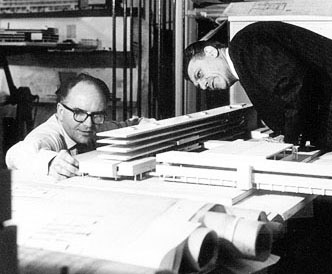
Bakema (left) giving the final touch to the model of the Civil Engineering building of Delft University. His colleague Van den Broek (right) making sure the last column is put in the right place.
Jaap Bakema
(1914-1981)

Bakema (left) giving the final touch to the model of
the Civil Engineering building of Delft University. His colleague Van den Broek
(right) making sure the last column is put in the right place.
Jacob Berend Bakema was born in Groningen on 8 March 1914. After completing
his studies at the Higher Technical College in Groningen and, inspired by the
Rietveld-Schröder House in Utrecht, he decided to become an architect.
In 1941 he graduated with distinction from the Amsterdam Academy of Architecture,
where one of his lecturers was Mart Stam. He went on to work under Cor van Eesteren
in the urban development division of the Amsterdam Department of Public Works.
During the Second World War he joined the architectural practice of Van Tijen
and Maaskant in Rotterdam and after the war he worked for the Rotterdam Public
Housing Agency.
In 1948 Bakema was approached by Johannes van den Broek (1898-1978) to co-manage
the firm Brinkman and Van den Broek Architects. In 1951, two years after Brinkman's
death, the Rotterdam architectural practice was renamed Van den Broek and Bakema.
The Van den Broek and Bakema firm was to play a leading role in the Dutch post-war
reconstruction effort and the resolution of the housing shortage. The firm achieved
international renown with projects like the Lijnbaan shopping centre (1949-53)
and the building for the stores of Ter Meulen, Wassen and Van Vorst (1948-51)
- both in Rotterdam. In the same period the practice had its first commissions
for Delft University of Technology, including the design of the Faculty of Architecture
(1959-64) and the Auditorium (1959-66). Among their most distinguished projects
are the housing at Hansaviertel, Berlin (1957-60), the town halls of Marl (1958-62)
and Terneuzen (1963-72), the Kennemerland regional plan (1957-59) and the monumental
Pampusplan (1965).
Bakema played an important part in the Rotterdam 'Opbouw' group, which, together
with the Amsterdam group 'de 8', made up the Dutch delegation of CIAM. In 1946
Bakema was invited to a CIAM congress for the first time. He became the secretary
of CIAM in 1955 and went on to prepare the tenth CIAM congress with the other
future Team 10 members, and then acted as coordinator at the last congress in
Otterlo. After CIAM was disbanded, Bakema played a prominent part in Team 10,
both as an energizing force and a binding figure who kept the group together.
His office acted as the 'post box' for the group's activities. Bakema was also
a board member of the society Architectura et Amicitia, publisher of the journal
Forum. From 1959-63 he was part of the editorial board of the magazine, which
also included Van Eyck and Hertzberger, using the magazine as a platform for
Team 10 ideas.

Transitional Elements, sketch by Bakema 1961
Bakema summarized his urban and architectural ideas under the notion of 'architecturbanism'
and 'Total Space', an idealistic, almost cosmological outlook on the human habitat
and existence.
In keeping with the CIAM line, the practice carried out research into new residential
districts and ways to develop a new approach to urban design. They applied the
ideas of the neighbourhood unit (the so called 'wooneenheid') and the visual
group to develop new dwelling types and ordering principles for urban functions.
In late1962 and early 1963 Bakema acquired national renown with the television
programme 'Van stoel tot stad' which led to the publication of Van stoel tot
stad; een verhaal over mensen en ruimte (From Chair to City; A Story of People
and Space, 1964).
Bakema became aprofessor at Delft University of Technology in 1964 and professor
at the Staatliche Hochschule of Hamburg in 1965, as well as a visiting professor,
among others at Columbia University (New York) and Cornell University (Ithaca).
Van den Broek left the practice in the early 1970s. Bakema stayed on until his
death on 20 February 1981. After his death the firm carried on and continues
to operate today under the name 'Architectenbureau Van den Broek en Bakema'.